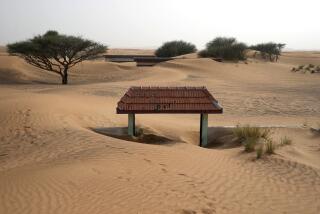Cairo Digs Into Its Past to Give Park-Starved Residents an Oasis
- Share via
CAIRO — When it comes to dust and din, perhaps no city on the planet can match Cairo, a desert-bound megalopolis clinging to the Nile whose 17 million people get by with only a few square feet of green space each.
For years, residents wanting fresh air or rambles away from their stifling apartments have had little alternative except to go to the crowded zoo, the traffic-packed bridges over the Nile or even the grassy medians on the road to the airport.
But now, in an unusual initiative combining horticulture, community development and archeology, the Aga Khan Trust for Culture has created a 74-acre park atop a 500-year-old garbage dump. The rare green space offers Cairenes what they have been missing: an oasis to call their own.
Dubbed Cairo’s “Central Park,” Al Azhar Park has been an instant hit.
It is lined with palms and ornamented by fountains, ponds, a stream, a waterfall and hundreds of thousands of new trees and plants. And it’s close to some of the Egyptian capital’s most historically significant sites: Saladin’s Citadel, the Khan al Khalili bazaar, the City of the Dead cemetery and the 1,000-year-old Al Azhar University.
From the terraces of the park’s Hilltop Restaurant, diners can look down the spine of the park to the magnificent citadel and the stately Alabaster Mosque built by Egyptian ruler Mohammed Ali, or turn slightly and look past the roofs of the Darb al Ahmar slum at the medieval minarets of Islamic Cairo and downtown toward the towers of the five-star hotels bestriding the river.
For a city famous for its chaotic, honking traffic and the omnipresent crush of humanity, the serenity and green of the park seems somehow un-Egyptian. The landscaping, the al fresco dining venues and the winding promenades smack of something from the high-priced resort hotels along Egypt’s Red Sea coast -- just without the lobby, the porters and the guest rooms.
On an evening during the waning days of the Islamic holy month of Ramadan, young couples, business executives and three-generational families hungrily flocked to iftars, or evening feasts to break the fast, held in the restaurant and the park’s lakeside cafe. Sated, they perambulated in the gathering dusk.
“It’s lovely -- one of the nicest things to happen to Cairo over the last 50 years,” said Max Rodenbeck, a longtime resident and author of “Cairo: The City Victorious.”
Some residents say the park’s pristine state will be short-lived, accustomed as they are to the fact that most public amenities are inevitably worn down and gritted by the climate, overuse and rather relaxed standards of maintenance.
Cameron Rashti, the project manager for the Aga Khan Trust’s Historic Cities Support Program, says that won’t happen. The park is well maintained with oversight from the trust, and will remain under its control for three years. After that, the city has the right to assume full control, but it may keep the current arrangement.
Rashti said he was quite satisfied with the reception to the park, which opened in August after a decade of planning and construction.
“It is pretty representative of the population of greater Cairo,” he said of the park’s visitors. “We are getting a pretty broad cross-section of visitors from all classes. There are officials and top business executives coming to the five-star restaurant, and large numbers of middle-class and lower-middle-class people visiting just for the experience of walking around the park.”
Like many other public spaces in Cairo, the park charges an admission fee, but it varies depending on the day of the week and the time of day, to make the park affordable for anyone. Discounts are offered to large families, students and the elderly. For most, admission costs about 60 cents.
The historic aspect of the project was the excavation of more than one mile of the wall Saladin built as part of the city’s defenses against the Crusaders in the late 12th century.
The area just east of the wall became the city’s refuse heap. Sand and garbage accumulated through the centuries, eventually creating a mound that covered the wall up to its 16-yard-high crenelated battlements.
To build the park, 80,000 truckloads of toxic sand and rubble were removed, the trust said. Three reservoirs were incorporated into the park, as were an estimated 655,000 flora, including palms, flowers and fruit trees on a hilltop lookout and formal garden.
The project also included aid to adjoining Darb el Ahmar, a low-income community of 240,000 people filled with narrow streets of housing, workshops and stores.
The Aga Khan trust used resident workers and is training others to help maintain the neighborhood. It rehabilitated homes and provided micro-credits to revive businesses. In all, the $30-million park project is expected to attract 1.5 million visitors a year and provide a new lease on life to the declining neighborhood.
Rashti said some elements still needed to be added, including a few food kiosks and a retail outlet selling plants from the park’s nursery. An amphitheater, beneath the 800-year-old wall, will be a venue for musical and cultural performances.
“Certainly it is dazzling just to walk along the Nile or sit in a building overlooking the Nile. But if you happen not to be right on the Nile, what do you do?” Rashti said. “The city has become huge, and you have to have more than one place to enjoy the open air.”
More to Read
Sign up for The Wild
We’ll help you find the best places to hike, bike and run, as well as the perfect silent spots for meditation and yoga.
You may occasionally receive promotional content from the Los Angeles Times.






